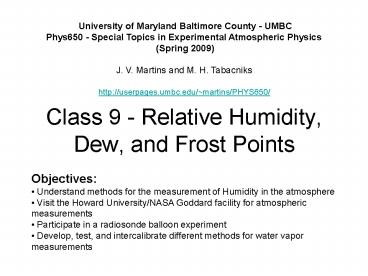Class 9 - Relative Humidity, Dew, and Frost Points
Title:
Class 9 - Relative Humidity, Dew, and Frost Points
Description:
Group 2 Development of a wet/dry bulb psychrometer The wet/dry bulb psychrometer will be made out of two bulb thermometers, a wet wicking fabric, ... –
Number of Views:30
Avg rating:3.0/5.0
Title: Class 9 - Relative Humidity, Dew, and Frost Points
1
Class 9 - Relative Humidity, Dew, and Frost Points
University of Maryland Baltimore County -
UMBC Phys650 - Special Topics in Experimental
Atmospheric Physics (Spring 2009) J. V.
Martins and M. H. Tabacniks http//userpages.umb
c.edu/martins/PHYS650/
- Objectives
- Understand methods for the measurement of
Humidity in the atmosphere - Visit the Howard University/NASA Goddard
facility for atmospheric measurements - Participate in a radiosonde balloon experiment
- Develop, test, and intercalibrate different
methods for water vapor measurements
2
Hands on component
- Students will be divided in 4 groups to develop
methods for the measurement of water vapor in the
atmosphere. Each group will develop a parallel
project that will be connected to the rest of the
class at the end of the experiment. This project
will take two classes to be concluded. The four
groups will perform the following experiments - Group 1 Development of an environmental chamber
- Students will develop an environmental chamber
that can produce variable and stable relative
humidities, which will be used for the
intercomparison of all the hygrometers produced
by the other groups. This group will also be
responsible for running the VAISALA humicap
sensor, which will provide the reference method
for intercalibrating all other techniques. - Group 2 Development of a wet/dry bulb
psychrometer - The wet/dry bulb psychrometer will be made out of
two bulb thermometers, a wet wicking fabric, and
an automated fan or pump system that will suck
the air sample through the system. - Group 3 Development of a passive chilled mirror
hygrometer - A chilled mirror device should be placed between
two heat reservoirs (1 cooled and one heated). A
distance scale between the two reservoirs must be
calibrated as a function of temperature. The
temperature of the heat reservoirs should be kept
as constant as possible and must be constantly
monitored to guarantee the integrity of the
measurements. - Group 4 Development of an active chilled mirror
hygrometer - A chilled mirror device should be built between a
cooled heat reservoir (liquid Nitrogen) and a
controlled heater device (resistor). The power
applied to the resistor will determine the amount
of heat on the heated side of the device and
should be measured constantly. The power on the
resistor must be varied in order to keep the dew
(or frost) point always in the same position on
the chilled mirror. The RH from the environmental
chamber should be used as a reference to
calibrate the power in the resistor. - In all cases, different temperature sensors may
be used to monitor the temperature of the system
in different locations. Aluminum or cupper foils
of different thicknesses will be used as the
initial chilled mirrors. Other materials may also
be tried. A smooth, shinny and clean surface are
important to produce and show good condensation
or frost.
3
Guidance for weekly report 8
- Describe what you learned with the visit to the
Beltsville facility and the balloon experiment - Make a bibliographic review and research on
methods to measure relative humidity in the
atmosphere. Make sure you cover at least the
following methods - Capacitive measurements of Relative Humidity (RH)
- The Vaisala Humicap sensor/methodology
- Wet/Dry bulb psychrometers
- Chilled mirror Hygrometers
- What are dew point and frost point temperatures?
- How can you determine the atmospheric RH based on
dew point measurements? - How can you determine the atmospheric RH based on
the wet/Dry bulb psychrometer? - Find out and describe the properties of different
solutions and/or phase transitions you can use
for the calibration of thermometers at different
temperatures or for the construction of the heat
reservoirs for your hygrometers - Describe your weeks experiment and the theory
behind it. Make sure you use drawings and/or
pictures to represent what you are trying to do - Read and describe the reference Vomel, H., D. E.
David, and K. Smith (2007), Accuracy of
tropospheric and stratospheric water vapor
measurements by the cryogenic frost point
hygrometer Instrumental details and
observations, J. Geophys. Res., 112, D08305,
doi10.1029/2006JD007224.
4
Interesting Web References
- The Waves Experiment there are many interesting
links here, including data from many radionsonde
launches with regular sondes and chilled mirror
devices - http//ecotronics.com/lidar-misc/WAVES.htm
- Vaisala Humidity Calculators
- http//www.vaisala.com/humiditycalculator/
- The YES Chilled mirror Hygrometer
- http//www.yesinc.com/products/data/cmh/index.html
- Dry Bulb, Wet Bulb and Dew Point Temperature
- http//www.engineeringtoolbox.com/dry-wet-bulb-dew
-point-air-d_682.html - Humidity Calculator
- http//www.humidity-calculator.com/index.php































